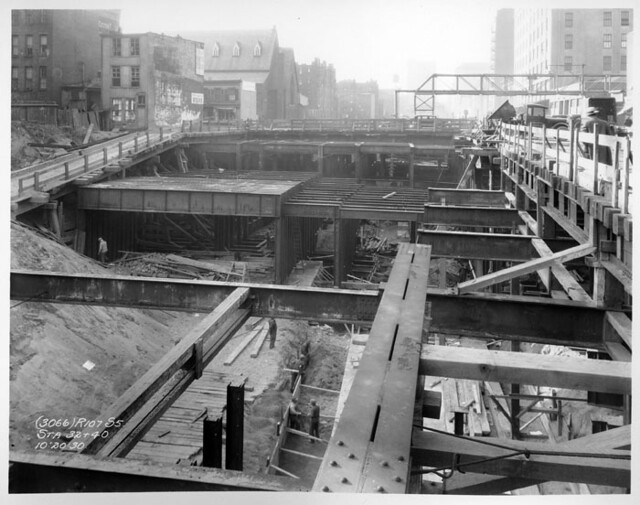
Construction progress for the IND Crosstown line (looking east toward the Court Street Station, now home of the Transit Museum) on Schermerhorn Street, Brooklyn, NY. October 20, 1930. (Photo courtesy of the Transit Museum)
In honor of its 35th Anniversary year, the Transit Museum — New York’s must underrated playground for subway enthusiasts — published a photoset to flickr today of scenes from the past three and a half decades. As a tantalizing glimpse at what lies in its archives, it fronted the set with the above shot from 1930 of the construction of the IND Crosstown line at Court and Schermerhorn Streets in Brooklyn. Looks like a mess, eh?
This historic shot got me thinking about the complaints surrounding construction along Second Ave. Once upon a time in New York City, subway construction was the norm. For 35 years in the early decades of the 20th Century, New Yorkers expected torn up streets cutting through neighborhoods in various states of development, and the resulting benefits included a vast new subway system. Yet, now, the last time cut and cover construction was employed in New York City, residents protested when parts of Central Park were dug up to make way for the 63rd St. tunnel.
Today, the Second Ave. Subway has turned a once-vibrant commercial and residential strip into a dust bowl of noise and construction fences. The MTA is trying to work with community groups to minimize the impact, but the authority has, to put it charitably, been less than successful in doing so. Now imagine if the scene from Court and Schermerhorn were transplanted to Second Ave. at 85th St. in 2011. That’s an unpleasant image, to say the least.
Many advocates for subway expansion have pointed to the costs of a deep-bore tunnel as an impediment to those projects, but the truth is more complex than that. Deep-bore tunneling isn’t significantly more expensive than cut-and-cover to justify what would arguably be a neighborhood-destroying project. It’s politically infeasible to propose cut-and-cover right now, and these scenes from the past remind us why.

14 comments
Great pics Ben. As for the SAS complaints, it’s indicative of the new “normal” in American politics. We want it all, we just don’t want to pay.
Cut and cover is a lot cheaper in a sane environment. A modern medium-size construction crew has the tools to dig a trench in the street, so ironically it would be easier to keep the workload local too. The turnover time on a segment of construction should be measured in months, not years. The costs of stations, tracks, signaling, etc. is at least as cheap as it would be for a deep bore.
If we lived under a public works regime that was at all sane, the whiners who these projects primarily benefit would be ignored and by the time they got these silly complaints to court the job would be done and there would be no real harm to sue about anymore.
While cut & cover is undoubtedly more intrusive, nothing justifies a $5B price tag and over a decade of construction for 3 new subway stations. Something tells me the line in that photo was 4 tracks and completed within some kind of reasonable time frame for some kind of reasonable cost.
Boring is more intrusive if you’re unlucky enough to be near the launch box, as some UES residents currently are. Another upside to cut & cover is it spreads the pain out more equitably.
To put it into perspective, to build the 4 1/2-mile Crosstown Line from Court Square to Hoyt-Schermerhorn using cut/cover (except the Newtown Creek Tunnel) cost 35mm in 1937 dollars. That’s around 549.2mm in 2011 dollars.
*http://query.nytimes.com/mem/archive/pdf?res=F50710FF3B551B7A93C5AB178DD85F438385F9
Second Ave is probably a lot more densely populated than the area at the time of this picture, so it’s probably impacting a lot more people.
In addition, I’d bet there are a lot more cars on the road today…
I know it’s counterintuitive, but more cars on the road only means fewer people inconvenienced.
Minor correction, that’s not the Crosstown line, that’s the Fulton Street line.
Seeing how ridiculously wide that is, it’s probably both the Crosstown Line and the Fulton Street Line! Either Hoyt-Schermerhorn itself or directly west of it.
This picture is of the intersection of Schermerhorn and Bond, looking West.
The office building to the right is still there, as is the church on the left (on State Street)
All the buildings on the south side of the street were demolished for the construction, and the street has not fully recovered 80 years later.
One real advantage of cut & cover is that you end up with a nice shallow tunnel. Advantage? It’s a lot quicker to get the station, and a lot quicker to get out of it. As a rider on Washington Metro I think about this a lot…the long escalator rides can significantly add to travel times. And operational costs (and energy): escalators and elevators, HVAC, ejectors…
I understand the frustration with current capital costs for transit projects. But comparing inflation adjusted costs from 1930 to today’s costs are comparing two different economies entirely. One can also hire servants much cheaper in Mozambique than here, but I think I’d rather live work and pay bills here.
Clifton Hood once said that parts of Manhattan were more crowded than Calcutta when the IRT was built. If generations of New Yorkers back then could endure it, so could we.
And if cut-and-cover truly is the faster method of construction, then it’s entirely worth this level disruption.
Could the cut and cover method work for the Rockaway Beach Branch?